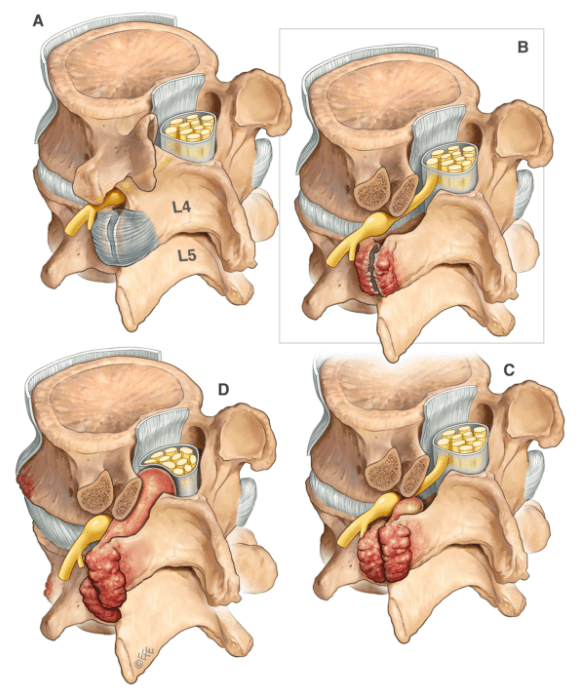Facet Syndrome
What is a facet syndrome?
Facet syndrome, known also as facet joint syndrome, refers to an arthritic condition affecting the joints of the vertebrae.
These vertebrae joints are called facets. Facets make up a crucial component toward facilitating the natural range of motion and stability of the spine as they connect adjacent vertebrae. They consist of cartilage that is lubricated by synovial fluid encased in a fibrous capsule, enabling a smooth sliding motion between the joints.

Various stages of facet degeneration
Primary function
The primary function of facet joints are to allow spinal flexion and extension while restricting the range of rotation and preventing slipping between the vertebrae.
Since facet joints experience almost constant motion, they are particularly at risk of arthritis and degeneration. This process is very common, and the joints become increasingly susceptible with age. Pain may result from swelling in the surrounding structures, leading to nerve root irritation. While this condition can occur anywhere in the spine, it is most common in the neck (cervical region) or lower back (lumbar).
Symptoms
Various symptoms can indicate that pain is associated with facet syndrome.
Typically, this pain manifests as a dull ache in the lower back directly above the spine (lumbar), and can disperse to the buttocks. Pain may periodically falre-up or be chronic. Pain can be induced through particular actions that involve movements such as bending backwards or twisting sideways toward the joint. Pain in the neck (cervical) can extend to the shoulders and back of the skull. Extensive periods of standing or inactivity can heighten symptoms.


Causes
Facet syndrome occurs when the facet joints break down and become inflamed.
The primary cause is often repetitive microtrauma, commonly associated with chronic degeneration, however, it cannot be confirmed without medical evaluations. Daily activities involving repetitive back extension, particularly movements with the arms above the head, can contribute to these injuries. Sports or other activities that involve frequent powerful hyperextensions of the lumbar spine may also lead to recurring injuries. Obesity can also be a contributing factor to increased spinal pressure. Fractures of the spine or other forms of sudden trauma can lead to facet syndrome.
Make an appointment
Your well-being is our priority, and we invite you to experience the transformative impact of advanced spinal care.